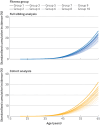Cardiorespiratory fitness in adolescence and risk of type 2 diabetes in late adulthood in one million Swedish men: nationwide sibling controlled cohort study
- PMID: 40791770
- PMCID: PMC12336507
- DOI: 10.1136/bmjmed-2024-001313
Cardiorespiratory fitness in adolescence and risk of type 2 diabetes in late adulthood in one million Swedish men: nationwide sibling controlled cohort study
Abstract
Objective: To examine the association between adolescent cardiorespiratory fitness and risk of type 2 diabetes in late adulthood, including the potential influence of unobserved familial confounding on the association.
Design: Nationwide sibling controlled cohort study.
Setting: Swedish Military Service Conscription Register, Sweden, 1972-95, with Multi-Generation Register for identifying full siblings. National Patient Register and Prescribed Drug Register for data on diagnoses of type 2 diabetes, deaths from National Cause of Death Register, and Statistics Sweden for emigration and socioeconomic data.
Participants: 1 124 049 Swedish men who participated in mandatory military conscription examinations with completed standardised cardiorespiratory fitness testing. Participants were followed up until 31 December 2023.
Main outcome measures: Type 2 diabetes, defined as a composite endpoint of diagnosis in inpatient or specialist outpatient care and dispensation of antidiabetic drug treatment, until 31 December 2023.
Results: 1 124 049 men, including 477 453 full siblings, with a mean age of 18.3 (standard deviation 0.7) years at baseline were included. During follow-up, 115 958 men (10.3%) and 48 089 full siblings (10.1%) had a first type 2 diabetes event at a median age of 53.4 (interquartile range 47.6-59.3) years. Cardiorespiratory fitness was categorised into deciles (referred to as groups, with group 1 being the lowest fitness level and group 10 the highest). In a cohort analysis, the adjusted hazard ratio in fitness group 2 versus fitness group 1 was 0.83 (95% confidence interval (CI) 0.81 to 0.85), with a difference in the standardised cumulative incidence at age 65 years of 4.3 (95% CI 3.8 to 4.8) percentage points, decreasing to a hazard ratio of 0.38 (0.36 to 0.39; incidence difference 17.8 (17.3 to 18.3) percentage points) in fitness group 10. When comparing full siblings, and thus controlling for all unobserved shared behavioural, environmental, and genetic confounders, the association was replicated, but with a reduction in magnitude. The hazard ratio in fitness group 2 was 0.89 (95% CI 0.85 to 0.94; incidence difference 2.3 (1.3 to 3.3) percentage points) and 0.53 (0.50 to 0.57; incidence difference 10.9 (9.7 to 12.1) percentage points) in fitness group 10. Hypothetically moving all participants in fitness group 1 to fitness group 2 was estimated to prevent 7.2% (95% CI 6.4% to 8.0%) of events at age 65 years in the cohort analysis versus 4.6% (2.6% to 6.5%) in the full sibling analysis, whereas hypothetically moving all participants to fitness group 10 was estimated to prevent 35.6% (34.1% to 37.0%) versus 24.3% (20.5 to 28.0) of events. Indications of effect modification by overweight status were found, where the association was smaller in those with overweight than in those without overweight, particularly in the full sibling analysis.
Conclusions: The findings indicate that adolescent cardiorespiratory fitness could be important in the development of type 2 diabetes in late adulthood, but conventional observational analysis might give biased estimates of the magnitude of the effect.
Keywords: Diabetes mellitus; Endocrinology; Epidemiology; Preventive medicine; Public health; Sports medicine.
Copyright © Author(s) (or their employer(s)) 2025. Re-use permitted under CC BY-NC. No commercial re-use. See rights and permissions. Published by BMJ Group.
Conflict of interest statement
All authors have completed the ICMJE uniform disclosure form at www.icmje.org/disclosure-of-interest/ and declare: no support from any organisation for the submitted work; MN is funded by grants from the Swedish Research Council; VHA is funded by grants from the National Institute for Aging and the National Institute of Neurological Disorders and Stroke; MBa is employed at the Swedish Medical Products Agency (Uppsala, Sweden); the views expressed in this paper do not necessarily represent the views of this government agency; MBr reports serving on advisory boards for AstraZeneca and Amarin, and receiving lecture honoraria from Amarin and Medtronic; MN reports serving on advisory boards for Johnson & Johnson and Itrim, and serving as a consultant for the Armed forces; no financial relationships with any organisations that might have an interest in the submitted work in the previous three years; no other relationships or activities that could appear to have influenced the submitted work.
Figures




References
-
- Strain T, Flaxman S, Guthold R, et al. National, regional, and global trends in insufficient physical activity among adults from 2000 to 2022: a pooled analysis of 507 population-based surveys with 5·7 million participants. Lancet Glob Health. 2024;12:e1232–43. doi: 10.1016/S2214-109X(24)00150-5. - DOI - PMC - PubMed
LinkOut - more resources
Full Text Sources
